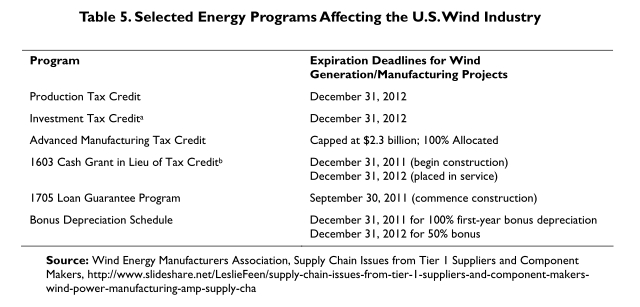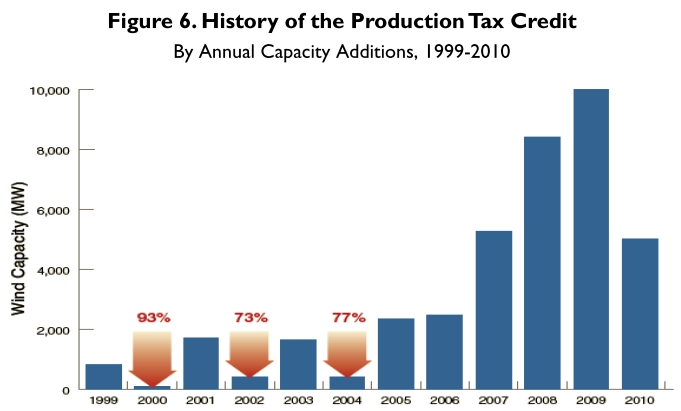Particularly in the wake of Solyndra, solar power gets a ton of attention. It’s at that interesting stage of development where big innovations and big failures lurk around every corner — lots of stories to tell. As sexy as solar is, though, wind power has grown faster and is a much larger, more mature industry. This is from IEA’s Renewables Information 2011:
Even as conservatives attack clean energy and the promise of green jobs, wind power has provided a growing source of domestic manufacturing. A new report from the nonpartisan Congressional Research Service (available via AWEA) goes over the numbers:
U.S. and foreign manufacturers have expanded their capacity in the United States to assemble and produce wind turbines and components. Nearly 400 U.S. manufacturing facilities produced wind turbines and components in 2010, up from as few as 30 in 2004. An estimated 20,000 U.S. workers were employed in the manufacturing of wind turbines in 2010. Because turbine blades, towers, and certain other components are large and difficult to transport, manufacturing clusters have developed in certain states, notably Colorado, Iowa, and Texas, which offer proximity to the best locations for wind energy production. The U.S. wind turbine manufacturing industry also depends on imports, with the majority coming from European countries, where the technical ability to produce large wind turbines was developed. Although turbine manufacturers’ supply chains are global, recent investments are estimated to have raised the share of parts manufactured in the United States to 50-60%, up from 25% in 2005.
This is what everybody says they want: a growing source of high-skill, high-wage manufacturing jobs in an industry with potential for almost unlimited growth over the next several decades. You’d think U.S. policymakers would bend over backward to support it and encourage its further growth, no?
No. Policy support for wind in America has been fragmented and inconsistent and much of it threatens to expire completely in the next few years.
As the CRS says, “future decisions about these policies will affect the extent to which wind turbine manufacturing becomes an important industrial sector in the United States.”
The main mechanism of support so far has been the production tax credit (first adopted under George H.W. Bush in 1992). Put aside the fact that tax credits are crappy renewables policy that discourage community ownership. (More on the evils of tax expenditures here.) If tax credits are going to be the policy instrument, at least they need to be consistent and predictable. America’s have been neither and the industry has sputtered because of it. CRS:
In each of the years during which the PTC lapsed (2000, 2002, and 2004), meaning that it expired prior to being renewed, the level of additional deployed wind capacity slowed or collapsed when compared to the previous year’s total: 93% in 2000, 73% in 2002, and 77% in 2004. Yet, when the PTC incentive was extended in 2004, 2007, and 2009, the industry responded positively, increasing wind power capacity compared to the previous year.
Now Congress is on the verge of blowing it again. This is no way to support an industry and no way to support job creation. The production tax credit is probably the best we can hope for out of this dysfunctional Congress, so … just renew the damn things already. Good jobs are on the line.
——
Addendum:
Of course, if America felt like joining the 21st century, it could adopt policies that are proven to spur large-scale deployment of renewable power. Indeed, according to the National Renewable Energy Laboratory (PDF), they are responsible for 75 percent of all solar PV and 45 percent of all wind development in the world. They have been implemented in over 50 countries, with a record of success in Germany, Denmark, China, Ireland, Brazil, Turkey, and elsewhere. The European Commission concluded (PDF) that they are “generally the most efficient and effective support schemes for promoting renewable electricity.”
They are called feed-in tariffs.






